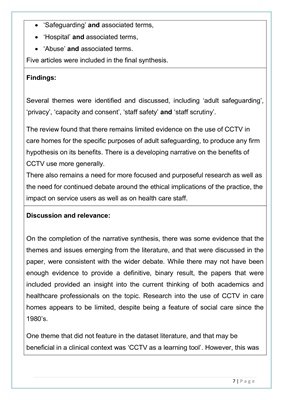
7 | P a g e
• 'Safeguarding' and associated terms,
• 'Hospital' and associated terms,
• 'Abuse' and associated terms.
Five articles were included in the final synthesis.
Findings:
Several themes were identified and discussed, including 'adult safeguarding',
'privacy', 'capacity and consent', 'staff safety' and 'staff scrutiny'.
The review found that there remains limited evidence on the use of CCTV in
care homes for the specific purposes of adult safeguarding, to produce any firm
hypothesis on its benefits. There is a developing narrative on the benefits of
CCTV use more generally.
There also remains a need for more focused and purposeful research as well as
the need for continued debate around the ethical implications of the practice, the
impact on service users as well as on health care staff.
Discussion and relevance:
On the completion of the narrative synthesis, there was some evidence that the
themes and issues emerging from the literature, and that were discussed in the
paper, were consistent with the wider debate. While there may not have been
enough evidence to provide a definitive, binary result, the papers that were
included provided an insight into the current thinking of both academics and
healthcare professionals on the topic. Research into the use of CCTV in care
homes appears to be limited, despite being a feature of social care since the
1980's.
One theme that did not feature in the dataset literature, and that may be
beneficial in a clinical context was 'CCTV as a learning tool'. However, this was